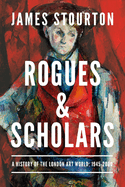
Anyone interested in the commerce of art knows the names Christie and Sotheby, but they should also know the name Goldschmidt. At London's Goldschmidt sale of 1958, "the modern art market was born," according to British art historian James Stourton: impressionist paintings sold for unprecedentedly high prices, burnishing the idea of art as a financial investment and London as the global market's red-hot center. Stourton lays it all out--skillfully and patiently, often wryly and sighingly--in Rogues and Scholars: A History of the London Art World: 1945-2000.
The years that followed the Goldschmidt sale, which was overseen by auction house Sotheby's, saw the demotion of dealers and the rise of auctioneers. Stourton has a conspicuously good time writing about the machinations of rivals Sotheby's and Christie's, which "became as aggressive, dominant and competitive in their field as Pepsi and Coca-Cola." Incorporating first-hand insights from interview subjects who were on the art scene at pivotal moments, Stourton introduces half a century's worth of noteworthy auctioneers, dealers, gallerists, and artists. Among them are commission fixers, a top-grade forger, and other rogues promised by the book title.
Much of Rogues and Scholars unfolds in swinging London, where movie and pop stars were increasingly making the art scene. Stourton (Heritage: A History of How We Conserve Our Past) has pieced together an absorbing character-based history-cum-exposé in which, in a probably unintentional reflection of the art world's then-ascendant fascination with celebrity, Mick Jagger's name appears more often than those of Cy Twombly, Robert Rauschenberg, or Jasper Johns. --Nell Beram, author and freelance writer

